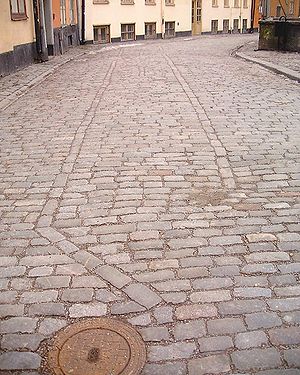
The rubbery surface allows the applied mechanical stress of footsteps to produce piezoelectricity
It could be the last word in concrete solutions to carbon emissions: a paving slab that generates electricity with every footstep taken on it, providing clean power to both cities and remote areas not connected to a national grid. Best of all, it requires mainly used tires and concrete.
The invention is the brainchild of industrial engineering graduate Laurence Kemball-Cook, who came up with the idea, perfected it in his final year at Loughborough University in central England, patented it, set up his company Pavegen and is now busy taking it to the world.
“I was studying the built environment and looking at solar and wind energy. I realized it is very difficult to get nice payback models on PV [photovoltaic solar cells] in urban spaces — you have got shading, planning restrictions — and wind is not great, either, because you have got turbulence,” he told ClimateWire.
“I left university, and the roller coaster started right there about two years ago. I started with about £50 in my pocket. We have gone through friends and family, high-net worth individuals, and now we have institutional backing,” he added.
As with many inventions, the idea seemed simple — the trick has been in putting it into practice and then fighting to take it to market. Each slab has a surface made of recycled truck tires and a base made of recycled polymer concrete.
From college hallways to battlefields?
So the start is with material that would likely have wound up in a landfill. Each footstep depresses the rubber surface by about 5 millimeters or a fifth of an inch. This, using a mechanism that Pavegen is loath to discuss, is converted into electricity that can either be stored, used immediately or — in bigger installations — transmitted to the national grid.
While Kemball-Cook didn’t discuss it, scientists and inventors have been working with a phenomena close to what he’s experimenting with since the middle of the 18th century. It is known as piezoelectricity, basically an electric charge that accumulates in certain solids, including crystals, bone and some polymers, in response to applied mechanical stress. The word is derived from the Greek verb piezo or piezein, which means to squeeze or press.
The U.S. Defense Advanced Research Projects Agency (DARPA) has made an attempt to power battlefield equipment by piezoelectric generators embedded in soldiers’ boots; however, the initial project was dropped because, among other reasons, the boots were uncomfortable.
As Kemball-Cook describes his invention: “Every time someone walks on the slab, it converts the kinetic energy from the footstep into electricity, so it is an off-grid power solution within urban spaces and transport infrastructure.”
“Ten slabs around a streetlight would power it all night long from the energy generated during the day. You can get 20 or 30 seconds of light from a small light fitting from one footstep. We are working on much bigger systems right now. Imagine covering Trafalgar Square with these slabs and harnessing all the electricity from the thousands of people who walk across it every day,” he added.
Read more . . .
Bookmark this page for “piezoelectricity” and check back regularly as these articles update on a very frequent basis. The view is set to “news”. Try clicking on “video” and “2” for more articles.







